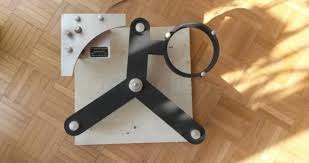Hello:
Last year I acquired a unique Transcriptor Skeleton TT and it came with a Mayware Formula-4 Tonearm plus a lightly used Grace F9 Cartridge.
I replaced the original belt that was stretched plus I Oiled the bearing well, it was almost bone dry.
The TT was not used for over 15 years.
Yet I have noticed that the original black plinth tonearm support has sagged, so the tonearm base has a few degrees lean to the limit of what the rear Mayware Unipivot can compensate for.
A normal tonearm with bearings could never work with this type of physical degradation of the tonearm base plate, and it seems to me that the weight of the Mayware Formula 4 tonearm and possibly the lid pushing down on the top screw over the years created the deformation of the original tonearm base plate assembly.
The Skeleton Triangular Base support material appears to be made of some 1970's MDF board, then painted matte black.
There is not a wealth of information on this turntable and I can see there were two versions, one plinth has a slot for the tonearm while the one I own has a round aluminum plate and a supporting ring with some knurled knobs to clamp the tonearm base plate to the ring.
Although the Skeleton table plays, I have to adjust the geometry of the stylus assembly to compensate for the mechanical aberration.
I would like to correct the geometry of the tonearm and need some suggestions and ideas.
My initial thought is to have a machine shop manufacture a pair of metal or plastic beveled washers to straighten out the arm where it fixes to the round aluminum plate, correcting the non-vertical with shimmed top and bottom washers lining them up so the armtube is normal while the tonearm round metal base plate remains as it is, with about a 5 degree lean.
The other thought I had would be to have the Plinth removed and taken to a 3D Printing company and actually duplicate it with a similar mass as the original so as not to upset the three main springs.
Or,, I can make a replacement plinth myself out of a suitable material. I am wary of trying to remove the deformed plinth and place some weight on it to slowly try to straighten it to be flat.
From what I can see of the pictures I can find, the original Vestigial arm allowed for vertical correction, so I am inclined to think that the plinth may have this tapered lean on purpose.
I have corresponded with a few Transcriptor owners and have not been able to get much help or advice.

The image above shows the round tonearm support ring, it is this connection to the rear spur that has deformed so the whole ring leans down by a few noticeable degrees.
I snapped a few photos of the issue but can't find them, so I will re-shoot a few tonight.
Thank you!
Richard